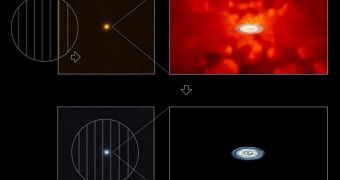It was long predicted that quasars may in fact be black holes found in the center of large discs of hot matter. However, it was never really proven through observations that this was in fact true. Confirmation now comes from a team of astronomers from the Max Planck Institute for Radio Astronomy in Bonn who used a light polarization technique to show how the surroundings of a black hole are able to output an amount of light one trillion times that of the Sun.
"After many years of controversy, we finally have very convincing evidence that the expected disc is truly there," says Makoto Kishimoto of the Max Planck Institute for Radio Astronomy.
Every galaxy is thought to house a quasar in its center, a region of space no larger that the solar system consisting of a central black hole and able to shine as much light as all the stars in a single galaxy, but how this process is accomplished remained largely unknown up to now. To solve this problem, physicists predicted that the powerful gravitational field of the central black hole would pull matter and shape it into a large accretion disk spinning around it, at the same time heating it to temperatures up to several hundred thousand degrees Celsius.
But this prediction still didn't say much about how this accretion disk would be visible. It wasn't until physicists predicted that the outer region of the disc could emit infrared light in a distinct spectrum that astronomers finally saw a possible means to detect the accretion disc. But there was still one problem. The infrared light coming from the clouds outside the accretion disc would interfere with that coming from the actual disc, making any observations useless. "The emission from hot dust grains in the surroundings is so strong that it buries emission from the accretion disc, so we just couldn't see it," Kishimoto said.
However, predictions also suggested that the light coming from the disc would be slightly polarized. Kishimoto's team argued that by looking only for the polarized part of the infrared light coming from the quasar, the glow of the disc should become visible immediately.
To test this theory, the team used the United Kingdom Infra-Red Telescope and the European Very Large Telescope to study six quasars located no farther than 5 billion light years away. The observations did indeed reveal that the predictions had been correct. "It looks like the standard picture is correct, which really moves the field of quasars forward," says Kishimoto.
The next step, according to the scientist, is to use the same technique to study certain portions of the disc in order to understand more about their structure and whether or not matter falls onto them in smooth or sudden bursts.

 14 DAY TRIAL //
14 DAY TRIAL //